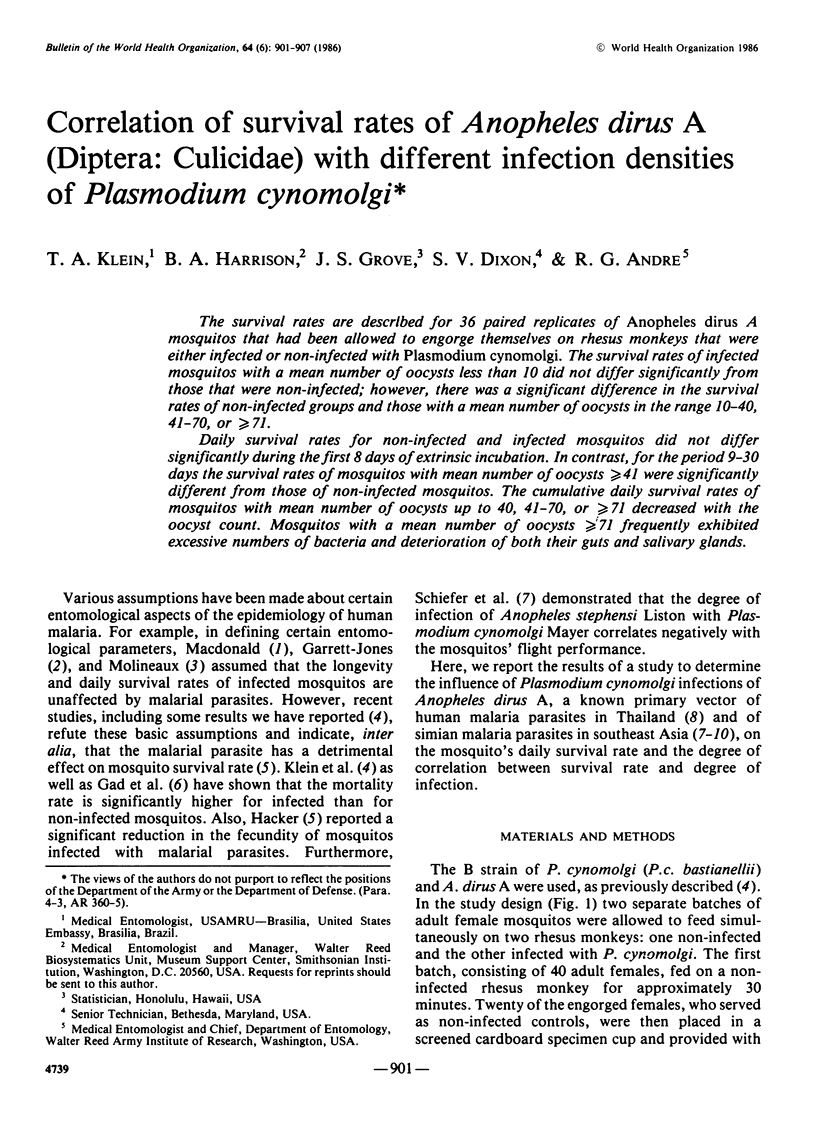Abstract
The survival rates are described for 36 paired replicates of Anopheles dirus A mosquitos that had been allowed to engorge themselves on rhesus monkeys that were either infected or non-infected with Plasmodium cynomolgi. The survival rates of infected mosquitos with a mean number of oocysts less than 10 did not differ significantly from those that were non-infected; however, there was a significant difference in the survival rates of non-infected groups and those with a mean number of oocysts in the range 10-40, 41-70, or ≥71.
Daily survival rates for non-infected and infected mosquitos did not differ significantly during the first 8 days of extrinsic incubation. In contrast, for the period 9-30 days the survival rates of mosquitos with mean number of oocysts ≥41 were significantly different from those of non-infected mosquitos. The cumulative daily survival rates of mosquitos with mean number of oocysts up to 40, 41-70, or ≥71 decreased with the oocyst count. Mosquitos with a mean number of oocysts ≥71 frequently exhibited excessive numbers of bacteria and deterioration of both their guts and salivary glands.
Full text
PDF






Selected References
These references are in PubMed. This may not be the complete list of references from this article.
- Cheong W. H., Warren M., Omar A. H., Mahadevan S. Anopheles balabacensis balabacensis identified as vector of simian malaria in Malaysia. Science. 1965 Dec 3;150(3701):1314–1315. doi: 10.1126/science.150.3701.1314. [DOI] [PubMed] [Google Scholar]
- EYLES D. E., WHARTON R. H., CHEONG W. H., WARREN M. STUDIES ON MALARIA AND ANOPHELES BALABACENSIS IN CAMBODIA. Bull World Health Organ. 1964;30:7–21. [PMC free article] [PubMed] [Google Scholar]
- GARRETT-JONES C. THE HUMAN BLOOD INDEX OF MALARIA VECTORS IN RELATION TO EPIDEMIOLOGICAL ASSESSMENT. Bull World Health Organ. 1964;30:241–261. [PMC free article] [PubMed] [Google Scholar]
- Gad A. M., Maier W. A., Piekarski G. Pathology of Anopheles stephensi after infection with Plasmodium berghei berghei. I. Mortality rate. Z Parasitenkd. 1979 Dec 1;60(3):249–261. doi: 10.1007/BF00929172. [DOI] [PubMed] [Google Scholar]
- Hacker C. S. The differential effect of Plasmodium gallinaceum on the fecundity of several strains of Aedes aegypti. J Invertebr Pathol. 1971 Nov;18(3):373–377. doi: 10.1016/0022-2011(71)90040-1. [DOI] [PubMed] [Google Scholar]
- Schiefer B. A., Ward R. A., Eldridge B. F. Plasmodium cynomolgi: effects of malaria infection on laboratory flight performance of Anopheles stephensi mosquitoes. Exp Parasitol. 1977 Apr;41(2):397–404. doi: 10.1016/0014-4894(77)90111-4. [DOI] [PubMed] [Google Scholar]


